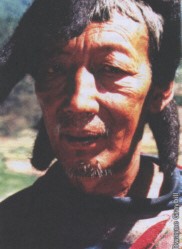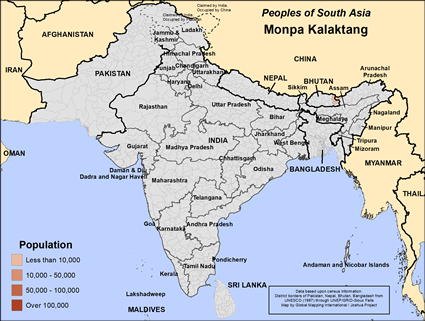Monpa Kalaktang in India

Photo Source:
Copyrighted © 2025
Peoples of the Buddhist World, Asia Harvest All rights reserved. Used with permission |

Map Source:
People Group data: Omid. Map geography: UNESCO / GMI. Map Design: Joshua Project
|
| People Name: | Monpa Kalaktang |
| Country: | India |
| 10/40 Window: | Yes |
| Population: | 1,400 |
| World Population: | 2,500 |
| Primary Language: | Monpa, Kalaktang |
| Primary Religion: | Buddhism |
| Christian Adherents: | 6.22 % |
| Evangelicals: | 0.00 % |
| Scripture: | Translation Started |
| Ministry Resources: | No |
| Jesus Film: | No |
| Audio Recordings: | Yes |
| People Cluster: | South Asia Tribal - other |
| Affinity Bloc: | South Asian Peoples |
| Progress Level: |
|
Introduction / History
The Kalaktang Monpa people live in the Kalaktang Circle of the West Kameng area of Tawang District in the northeastern Indian state of Arunachal Pradesh.
The Kalaktang Monpa have been granted status in India as a Scheduled Tribe, but there needs to be more research to determine their ethnolinguistic relationship to other tribal groups, including the large Tsangla group. Although the Kalaktang Monpa language and culture appear to be quite different from those of most of the other Monpa groups, there are very few differences between the Kalaktang Monpa and the Dirang Monpa (even though the Indian authorities' investigations led them to grant separate tribal status to each group).
The Kalaktang Monpa are the original inhabitants of the Kalaktang circle, from which they take their name. In the past the Kalaktang Monpa did not possess a script, so their history was handed down in oral stories. Elderly Kalaktang Monpa men recall that their ancestors migrated to their present location from the Bumthang and Thalong areas in eastern Bhutan.
What Are Their Lives Like?
The Kalaktang Monpa have an exciting culture. They are 'skilled in dyeing, weaving, papermaking, carpentry, cane and bamboo work. They perform popular forms of a mask dance.' Another source says, 'they have many pantomime dances which are generally performed during the annual festivals, both in the monasteries and in the villages. The Ajilamu and yak dances are very popular.'
All Kalaktang Monpa were traditionally employed in farming or trading, but in recent years the Indian government has implemented various schemes and projects in the Kalaktang Monpa area. Consequently, many people have new occupations like office jobs, teaching and contract work. Medical centers, schools, banks and a postal system are now operating in the Kalaktang area.
What Are Their Beliefs?
All Kalaktang Monpa are Tibetan Buddhists. 'Their sacred place is called goompha which is adorned with the images of Lord Buddha and the Bodhisattvas (incarnations of Lord Buddha). The lama is their priest, and his services are required to perform the birth, marriage and death rituals. Simultaneously they practice pre-Buddhistic animism or shamanism. The animistic priest, called phrame, cures diseases and removes evil spirits.
They share a common goompha with the other Buddhist communities. Some of the Kalaktang Monpa send their children to the goomphas in the different parts of the country to acquire training in Lamaism. They have also established matrimonial and religious links with the other Monpas, Sherdukpens, Tibetans, Khambas and Membas.
What Are Their Needs?
There are no known Christians among the Kalaktang Monpa tribe. Their communities are extremely tightly sealed, and people generally are not open to outside influence.
Prayer Points
Pray these people will have their hearts ready to receive the good news.
Ask God to send the appropriate workers to share the salvation and hope that Jesus brings.
Pray for the Holy Spirit to bring about a powerful Disciple Making Movement among the Kalaktang Monpa people, both in India and Bhutan.